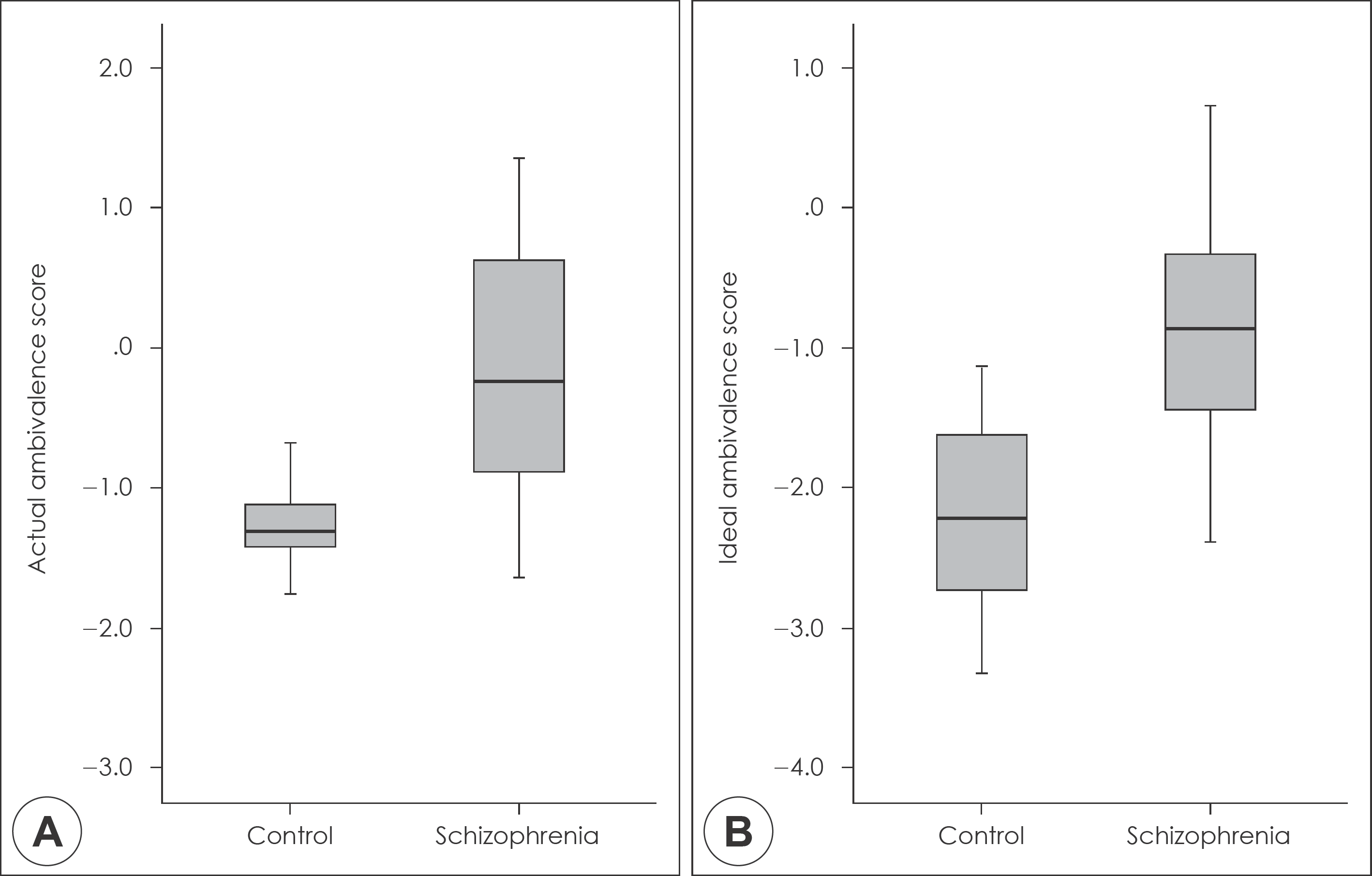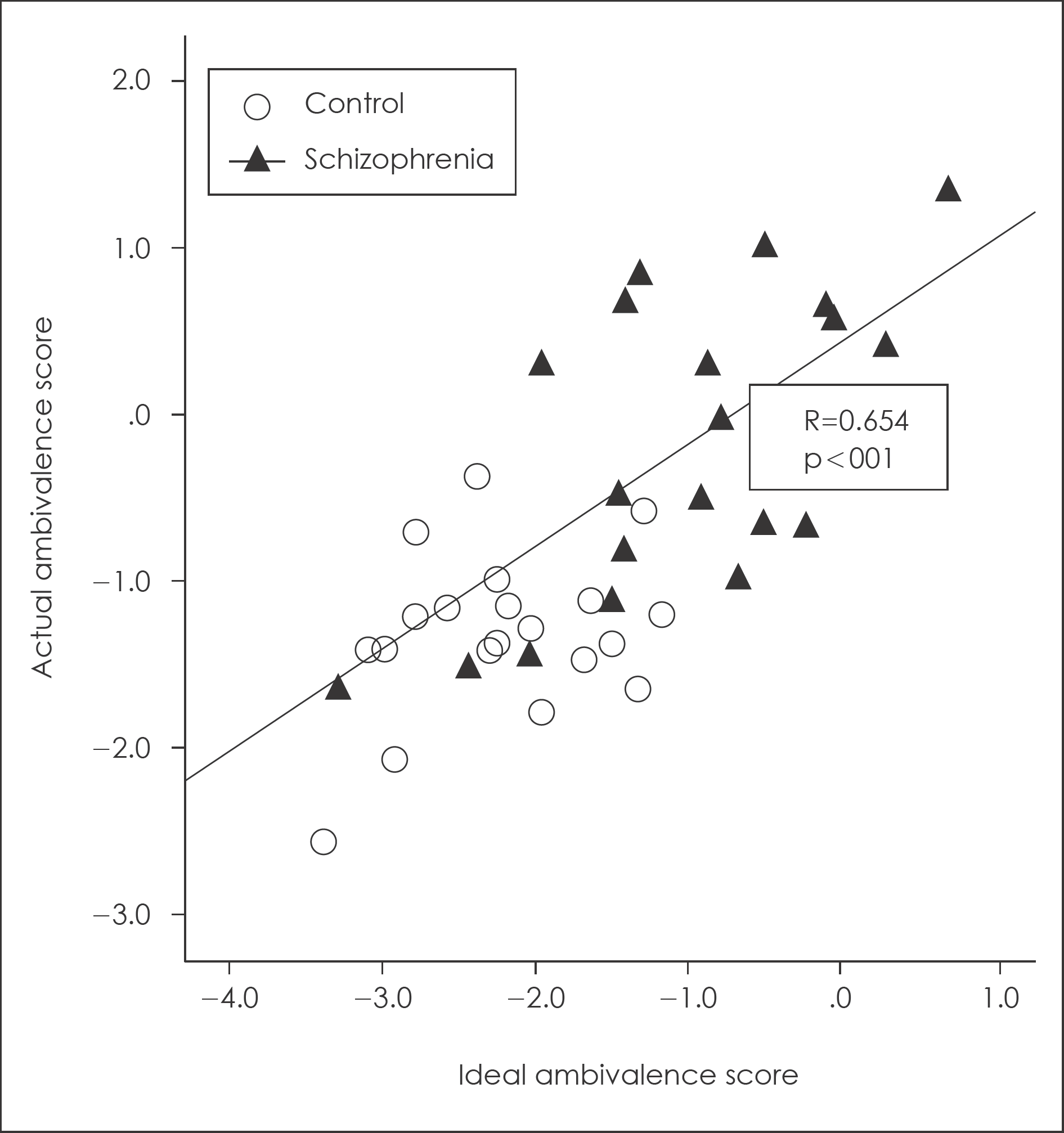Abstract
Objectives
Ambivalence of self-image is considered to be important in patients with schizophrenia since impairment of self-referential processing and increment in ambivalence are illness-related symptoms. This study aimed to evaluate quantitative and qualitative properties of ambivalence of self-image in patients with schizophrenia.
Methods
Twenty patients with schizophrenia and 20 normal controls performed a set of ‘self-image reflection task’ and then the level of ambivalence towards actual and ideal self-image were numerically scored. Ambivalence scores were compared between groups and correlation analyses with psychometric scales were done in each group.
Results
Patients with schizophrenia had higher level of ambivalence towards both actual and ideal self-image (p<0.001). Normal controls showed significant correlations with the scales representing level of self-concept clarity (r=-0.480, p=0.033), depression (r=0.479, p=0.033), and self-esteem (r=-0.555, p=0.011; R=-0.600, p=0.005) while the patients did not.
Go to : 
REFERENCES
1). Sass LA, Parnas J. Schizophrenia, consciousness, and the self. Schizophr Bull. 2003; 29:427–444.

2). Fisher M, McCoy K, Poole JH, Vinogradov S. Self and other in schizophrenia: a cognitive neuroscience perspective. Am J Psychiatry. 2008; 165:1465–1472.

3). Lee JS, Kim ES, Kim EJ, Kim J, Kim J-J. Relationship Between Self-Referential Processing and Intrinsic Motivation in Patients with Schizophrenia. Korean Journal of Schizophrenia Research. 2015; 18:73–78.

5). Kinderman P, Bentall RP. Self-discrepancies and persecutory de-lusions: evidence for a model of paranoid ideation. J Abnorm Psychol. 1996; 105:106–113.

6). Bleuler E. Dementia praecox or the group of schizophrenias. In-ternational Universities Press. 1950.
7). Freud S. The dynamics of transference. Rev Fr Psychanal. 1952; 16:170–177.
8). Costello CG. Symptoms of schizophrenia. New York: J. Wiley;1993.
9). Raulin ML. Development of a scale to measure intense ambivalence. Journal of Consulting and Clinical Psychology. 1984; 52:63.

10). Kwapil TR, Mann MC, Raulin ML. Psychometric properties and concurrent validity of the Schizotypal ambivalence scale. J Nerw Ment Dis. 2002; 190:290–295.

11). Jung YC, Seok JH, Chun J, Lee JD, Park HJ, Kim JJ. Brain Re-gions Associated with Ambivalence in Healthy Adults: A PET Correlation Study. Journal of Korean Neuropsychiatric Association. 2006; 45:191–198.
12). Jung YC, Park HJ, Kim JJ, Chun JW, Kim HS, Kim NW, et al. Reciprocal activation of the orbitofrontal cortex and the ventrolat-eral prefrontal cortex in processing ambivalent stimuli. Brain Res. 2008; 1246:136–143.

13). Kim JJ, Park HJ, Jung YC, Chun JW, Kim HS, Seok JH, et al. Evaluative processing of ambivalent stimuli in patients with schizophrenia and depression: a [15O] H2O PET study. J Int Neuropsychol Soc. 2009; 15:990–1001.

14). Park KM, Kim JJ, Seok JH, Chun JW, Park HJ, Lee JD. Anhedo-nia and ambivalence in schizophrenic patients with fronto-cere-bellar metabolic abnormalities: a fluoro-d-glucose positron emission tomography study. Psychiatry Investig. 2009; 6:72–77.

15). Spitzer R, Williams J, Gibbon M, First M. Structured clinical in-terview for DSM-IV. Biometrics Research: New York;1994.
16). Campbell JD, Trapnell PD, Heine SJ, Katz IM, Lavallee LF, Lehman DR. Self-concept clarity: Measurement, personality correlates, and cultural boundaries. Journal of Personality and Social Psychology. 1996; 70:141.

17). Beck AT, Steer RA, Ball R, Ranieri W. Comparison of Beck Depression Inventories -IA and -II in psychiatric outpatients. J Pers Assess. 1996; 67:588–597.
18). Rosenberg M. Society and the adolescent self-image. Princeton University Press. 1965.
19). Kay SR, Fiszbein A, Opler LA. The positive and negative syndrome scale (PANSS) for schizophrenia. Schizophr Bull. 1987; 13:261–276.

20). Andreasen NC. Scale for the Assessment of Positive Symptons: (SAPS): University of Iowa. 1984.
21). Andreasen NC. Scale for the Assessment of Negative Symptoms (SANS);1981.
22). Spitzer RL, Gibbon M, Williams J, Endicott J. Global assessment of functioning (GAF) scale. Outcome Assessment in Clinical Prac-tice. 1996. 76–78.
23). DeMarree KG, Morrison KR, Wheeler SC, Petty RE. Self-ambiv-alence and resistance to subtle self-change attempts. Pers Soc Psychol Bull. 2011; 37:674–686.

24). Priester JR, Petty RE. The gradual threshold model of ambivalence: relating the positive and negative bases of attitudes to sub-jective ambivalence. J Pers Soc Psychol. 1996; 71:431–449.

26). Jung YC, An SK, Seok JH, Kim JS, Oh SJ, Moon DH, et al. Neu-ral substrates associated with evaluative processing during co-acti-vation of positivity and negativity: a PET investigation. Biol Psychol. 2006; 73:253–261.

27). Seok JH, An SK, Lee E, Lee HS, Lee YJ, Jeon JH, et al. Behav-ioural evidence of blunted and inappropriate affective responses in schizophrenia: lack of a ‘negativity bias.' Psychiatry Res. 2006; 142:53–66.
Go to : 
 | Fig. 1.Independent t-test comparison of ambivalence scores between groups (A). Comparison of the actual ambivalence score (B). Comparison of the Ideal ambivalence score. |
 | Fig. 2.Scatter plot showing correlation analysis of the Actual ambivalence score and the Ideal ambivalence score. |
Table 1.
Within-group correlation analysis of the two ambivalence scores and the psychometric scales
| SAS | SCCS | BDI | RSES | |||
|---|---|---|---|---|---|---|
| Control | Actual ambivalence score | Correlation coefficient | 0.349 | -0.480∗ | 0.479 | -0.555 |
| p-value | 0.131 | 0.032∗ | 0.033∗ | -0.011∗ | ||
| Ideal ambivalence score | Correlation coefficient | 0.320 | -0.398∗ | 0.183 | -0.600 | |
| p-value | 0.169 | 0.082∗ | 0.439 | -0.005∗∗ | ||
| Schizophrenia | Actual ambivalence score | Correlation coefficient | -0.315 | 0.257∗ | 0.286 | -0.122 |
| p-value | 0.177 | 0.274∗ | 0.221 | -0.608 | ||
| Ideal ambivalence score | Correlation coefficient | -0.189 | 0.127 | 0.372 | -0.137 | |
| p-value | 0.424 | 0.593 | 0.106 | -0.566 |




 PDF
PDF ePub
ePub Citation
Citation Print
Print


 XML Download
XML Download